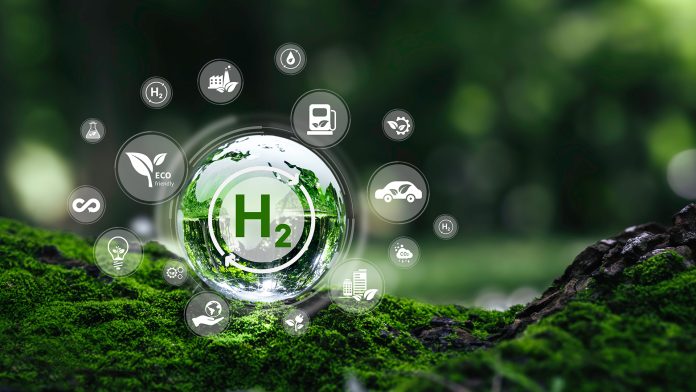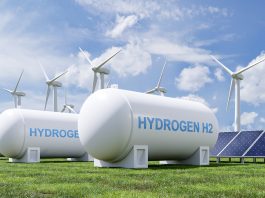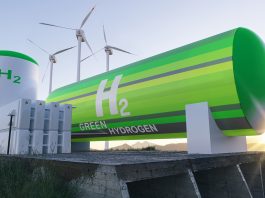Issues have persisted with hydrogen production and the economy needed to sustain it globally. Bart Biebuyck, CEO of Green Energy Park with over 20 years of experience in the hydrogen industry, discusses how his company will do things differently.
Hydrogen is a somewhat elusive molecule to be used as fuel. While it is an extremely efficient and emissionless fuel, the sticking point has been the lack of infrastructure to support it, i.e. industries using hydrogen fuel, amount being produced, etc., as well as the emissions created in its production.
The Innovation Platform’s Matt Brundrett sat down with Bart Biebuyck to talk about Green Energy Park, and what he thinks will be a future that will solve these issues in both hydrogen production, and supply and distribution. Bart, with his vast experience in the hydrogen industry, expands on his headship of a public private partnership with the European Commission, and explains how they will lead the way forward.
Could you provide an overview of Green Energy Park and what projects it’s working on or has worked on in the past?
Green Energy Park is a vertically integrated company that focuses on the production of hydrogen and ammonia in the upstream. Then, in the midstream, bringing that to different consumers in the distribution channel, and finally in the downstream, delivering to the gate of companies. We strongly believe that being vertically integrated is the best way to create a sustainable, viable, and economical hydrogen economy because the hydrogen economy is not yet mature, so there are too many variables. Being completely vertically integrated is, in our opinion, the way forward.
And this is precisely what we are doing with Green Energy Park. That’s why we are starting to build the world’s largest hydrogen and ammonia production facility in Brazil; then, we will bring its product to various ports worldwide. We are in talks with several ports in Europe. We have our own European import terminal on the Croatian island of Krk. This is where we have the Green Energy Park Krk, and the other ports we are working with are in the UK, north and northwest Europe, and the Middle East and the Far East.
From there, we are in discussion with various customers that we will bring hydrogen and ammonia to. They are located in northern Italy, south Germany, Austria, the Balkan countries, Croatia, Hungary, and Slovakia. This is where we believe we must gradually build a sustainable hydrogen economy. Of course, more energy parks will be built in the future, and we are already in discussion with other locations worldwide about setting up similar hydrogen production facilities.
Why is the Piauí location in Brazil so important for Green Energy Park?
In Brazil, we found all the elements required to make what I believe will be the world’s most affordable hydrogen and ammonia. We have a 100% green grid, a free trade zone, and a very close location to our brand-new port. We’re going to operate the export terminal in the state of Piauí. On top of that, we have excellent support from the local government, which believes in hydrogen and has a hydrogen strategy.
Furthermore, many Brazilian developers have concrete plans to produce renewable energy from solar and wind, but do not find off takers as the grid already 100% green. We will enable them and receive electricity and renewables at a very sharp price. We also have access to fresh water as we are very close to a river. All those elements together mean we can produce hydrogen and ammonia at a very affordable price.
We also have a lot of land there; around 800 hectares of free trade zone for ourselves, and we will use around 310 hectares. That leaves space open for off-takers of the ammonia and hydrogen locally. I’m sure there might be other locations of interest in the future. But for the moment, we feel that all the elements are there in Piauí to make a sustainable business case for hydrogen.
The development will be across four phases. The first phase will construct a 1.8-gigawatt electrolyser starting operation in 2028. Then phase 2 will add another 1.8 gigawatts in 2030, another 1.8 gigawatts in 2032, and finally, we will add 5.4 gigawatts in 2035. The entire project will be fully operational by then, and will be a demonstration of how to make hydrogen economical.
How much ammonia and hydrogen is planned for production, and to whom will it be sent?
We will produce around 2.4 million tonnes of hydrogen, leading to more than 10 million tonnes of ammonia, depending on the conversion rate and technology we use. We will deliver most of that to Europe because Europe is hungry for energy and needs to go green. Today, there are relatively few renewables available in Europe, so we need to bring these renewable electrons to Europe, which will be one of the biggest off-takers.
We are also looking to the UK, as they, too, are very energy-hungry. The Middle East may also be an exciting area to look at. It is generally believed that the Middle East will always export energy, and so far, they have done so, but I’m not sure that will always be the case. They will be competitive in their export of renewable energy versus other parts of the world. So, I could envision that the Middle East might import energy in the future and use it to create other added-value products. And then there is also the Far East. If you look at Japan, South Korea, Singapore, etc., they also need a lot of energy, especially renewable energy, so we are also looking at these markets.
How does this project fit in with the government’s climate goals? Has it received any incentives? And specifically, what about the Global Gateway initiative?
Globally, there is a race to address climate targets. We need new technologies and a lot of renewables. We cannot decarbonise our entire society by electricity alone; we will also need molecules. There aren’t many projects worldwide, at least at such a scale, that will produce a lot of green molecules, so to reach the government’s 2035, 2040, 2050, etc. targets, current income streams are not enough if we want to become net zero. We will need to build many facilities to create green molecules and truly implement them as a part of decarbonisation pathways.
There are a lot of industries that cannot use electricity very easily and will need to use molecules for energy. A lot of the time, those are also the industries that are putting out a lot of emissions. If you look only at the steel industry, 7% of global CO2 emissions come from steel. Our project fits wonderfully with all of the aforementioned targets and will help governments’ achieve their targets. Furthermore, our project is now part of the Global Gateway initiative. This is the European initiative undertaken by the EU Member States and the European Commission to build closer relationships with countries in Latin America and countries in Africa. Last year, the President of the European Commission went to Brazil and, in June, announced that they would invest in Brazil, including the hydrogen value chain. Thus, we are now one of the projects that are part of that hydrogen value chain in Brazil.
We are currently discussing the financial support we will receive under that framework. Other facilities are in operation in Brazil because of the innovation there. As such, we are also looking at funds that can help with the engineering activity we must undertake. Ultimately, we aim to deliver a hydrogen or ammonia price that is competitive with today’s fossil-fuel-based prices once the project is completed and operational.
I strongly believe that we need to go in that direction and show that it’s economical and viable. This is why, together with Green Energy Park’s top-down team, including an engineering company, an EPCM company, and a solid financial company with a lot of experience, we have developed a business model, new engineering, and a new way of financing. It’s quite an innovative business model, which is also part of our IP. When we explain that business model to various banks, be it private or institutional, they all love this new business model.
That’s why I feel there is traction in the financial world. We have received a great deal of enthusiasm when discussing and demonstrating our method to build a viable and economical hydrogen economy. I have even had several people tell me I’ve cracked the code. Today, one of the biggest issues is that many projects do not reach FID because they have various issues with their business model.
We worked hard here because we have an in-house engineering company with one of the brightest engineers in Process Engineering, tank engineering, etc. Combined with brilliant people in the financial world, they came up with that very interesting model that got a lot of traction when tested in the financial world. And so, yes, we’re likely to get a lot of development funding, but I think our new approach convinces many investors. I believe this is what was necessary. We cannot keep it business as usual and do things like we always have. You need to innovate, not only in engineering but also financially.
Have you encountered any logistical issues with exports or imports of ammonia and hydrogen?
There’s already a massive market for ammonia. Today, a lot of grey ammonia is being used worldwide; almost 200 million tonnes of ammonia consumption worldwide. However, this is from fossil-fuel-based ammonia. Of course, this needs to go green. I think there’s not such a big problem with import/export or handling because the world knows how to deal with ammonia. There are a lot of skilled people and companies who know what to do, and that is part of our joint venture. They have built several ammonia terminals, including the biggest ammonia tank in operation in the world. The challenge is, of course, what do you do with the hydrogen? Making ammonia from hydrogen is a known technology. However, converting back to hydrogen is still a challenge, and technology is still being developed.
We believe our technology is quite innovative for ammonia cracking. Our cracking technology can also solve issues with exporting to different customers. Bringing hydrogen to your import terminal and then to the customer is challenging.
We all know that building a hydrogen economy will take a decade, if not more, before everything is in place. Plus, not all the big companies, or even small and medium enterprises, are located next to the backbone. A lot of work is still needed to bring the hydrogen to each of those companies. But with our technology and solutions, we have created a way to get hydrogen to companies’ gates in a financially affordable way.
Could you go into more detail about green energy Park Krk, and how it aligns with your goals?
Green Energy Park Krk (GEPK) is a unique import facility. Krk is a Croatian island on the north side of the Adriatic Sea, the closest location to south Germany and northern Italy. GEPK is a 156-hectare brownfield plot that used to be an external chemical plant, which we can now use for the green energy future.
From GEPK, we can supply northern Italy, Austria, south Germany, the Balkan regions, and local markets like Croatia and Slovenia. At the moment, most European projects focus on Antwerp, Rotterdam, Hamburg, and those ports. But south-central Europe is not as well supplied. So with Krk, which is uniquely located, we can supply those regions; there’s a lot of interest.
Many companies are interested in supplying or sourcing green molecules from GEPK. What is beautiful is that our facility is also a port. We have 16m of natural depth; this is very important because ships carrying ammonia are heavier and need at least 14.5m of depth. We don’t need to dredge, as it’s a deep natural port. Furthermore, the port is in the Bay of Rijeka, meaning the waves are very moderate; there is no significant movement of sand or silt. This is also good for the shipments in terms of loading and unloading the shipping, as the ships do not rock much.
We also have a natural gas pipeline that is already hydrogen-ready. Once the Croatian government decides to stop natural gas and switch to hydrogen, we can immediately inject it from our side because the gas pipeline starts and runs on our side. Therefore, GEPK is already a part of the European hydrogen economy. In the future, there will also be a direct rail connection to the other side and the possibility of a pipeline going towards the refineries on the other side of the bay. So there are a lot of potential off-takers in the neighbourhood, as well as the potential to get hydrogen in large volumes off the island to major regions like northern Italy and south Germany.
What can you tell us about yourself and your work in the industry?
I’ve already worked in the hydrogen industry for more than 20 years. I started my career at Toyota Motor Europe on the design team for the first Toyota hydrogen car, the Mirai. I worked with my team on the Mirai for more than seven years, ensuring it was ready for the European market. I also built, the first hydrogen refuelling station in Belgium, over ten years ago. At that time, there was little talk about hydrogen power and little knowledge among hydrogen authorities. A lot of education was needed for all different stakeholders. But we built it, and it’s still operational today.
After we launched the Mirai and opened the hydrogen refuelling station, I had the opportunity to go to the European Commission to be the head of the world’s biggest hydrogen and fuel cell research programme. And so I was heading a €2.4bn research programme for seven years. I think we financed more than 1,100 companies in the field of hydrogen fuel cells; a total of around 360 projects in the meantime received funds. It was an exciting environment to work in because you saw all the latest technology, which technology works, which technology needs some development before it works, etc., so I learned a lot.
For me, it was essential to demonstrate how to make the hydrogen economy a reality. Every week, I saw companies coming up with projects and PowerPoints. But if you look at the latest IEA report, there are probably around 1,400 projects worldwide in hydrogen and fuel cells, and only 3.6% get FID; it made me a bit sad. However, I also embraced the challenge to show the world how we can realise a hydrogen economy. To achieve this, after leaving the European Commission in May last year, I started Green Energy Park Global with my team, who truly are the best of the best.
With a big, well-known engineering company, a well-known EPC company and somebody who saw everything in the financial world, together we set out to show the world how we can reach climate goals because to reach the 1.5 degrees climate target in 2050, we need to build about 6,000 gigawatts-worth of electrolysers to produce all the hydrogen and ammonia, or methanol that we need to decarbonise our economy. That’s a huge amount. Currently, the biggest electrolyser in operation in Europe is 20 megawatts, a fraction of what we need. And we have just 25 years to build 6,000 gigawatts of renewables and electrolysers, a massive challenge for humanity.
I want to contribute by showing a way forward and making hydrogen an economically viable case. And I’m thrilled that we succeeded. Of course, a lot still needs to be built, but as I said before, we are checking our model and designs because our engineers have already started designing a large part of our plot. When we show it to strategic partners, companies that have worked for years in this field, or investment banks, they say it’s fantastic. One CTO of a large company said: “Every day, I see presentations, and every week, some developers and companies show me their plans on hydrogen and ammonia. But this is my first time seeing something that might actually work.” I think it’s clear that we are on the right track to deliver a method that can accelerate the entire hydrogen industry and reach the 6,000 gigawatts required by 2050.
Please note, this article will also appear in the 18th edition of our quarterly publication.









